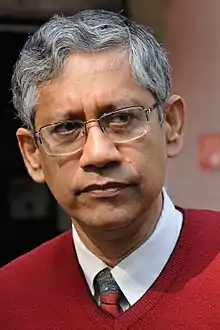Santanu Bhattacharya
Santanu Bhattacharya (born 1957) is an Indian bioorganic chemist and a professor at the Indian Institute of Science.[1] He is known for his studies of unnatural amino acids, cyclic peptides and biologically active natural products[2] and is an elected fellow of the Indian National Science Academy[3] The World Academy of Sciences[4] and the Indian Academy of Sciences[5] The Council of Scientific and Industrial Research, the apex agency of the Government of India for scientific research, awarded him the Shanti Swarup Bhatnagar Prize for Science and Technology, one of the highest Indian science awards, in 2003, for his contributions to chemical sciences.[6] He is also a recipient of the National Bioscience Award for Career Development of the Department of Biotechnology (2002)[7] and the TWAS Prize (2010).[8]
Santanu Bhattacharya | |
|---|---|
 | |
| Born | 23 April 1957 West Bengal, India |
| Nationality | Indian |
| Alma mater | |
| Known for | Synthesis of unnatural amino acids, cyclic peptides, DNA binding small molecules, and biologically active natural products |
| Awards |
|
| Scientific career | |
| Fields | |
| Institutions | |
| Doctoral advisor |
|
Biography

Santanu Bhattacharya, born on 23 April 1957 in the Indian state of West Bengal, graduated in chemistry (BSc hons) from Calcutta University and continued at the university to complete his master's degree from Rajabazar Science College.[3] Moving to the US, he enrolled for his doctoral studies on bioorganic chemistry at the laboratory of Robert A. Moss of the Rutgers University – New Brunswick and after securing a PhD in 1988, he did his post-doctoral studies with Har Gobind Khorana, a Nobel laureate at the Massachusetts Institute of Technology; the theme of his studies being signal transduction of membrane proteins.[9] On his return to India, he joined the Indian Institute of Science where he served as an assistant professor (1991–96), associate professor (1996–2001) and a professor (since 2001);[10] he continues at IISc as the chair of the department of organic chemistry.[11] He also serves as an honorary professor of Jawaharlal Nehru Centre for Advanced Scientific Research at their chemical biology unit.[3]
Legacy
Focusing his researches on the interfaces of chemistry and biology, Bhattacharya is reported to have made notable contributions in the design and synthesis of unnatural amino acids, cyclic peptides, DNA binding small molecules, and other biologically active natural products.[12] He has carried out several projects which include lipid molecular design and biophysics, peptide designs, structural studies of micelles, DNA binding anti-cancer agents,[13] and design and synthesis of nanomaterials.[3] He has published his researches by way of several peer-reviewed articles;[14] the online repository of the Indian Academy of Sciences has listed 117 of them.[15] On the academic administration front, he established a laboratory for bio-organic and supramolecular studies at Indian Institute of Science. He has supervised the post-graduate, doctoral and post-doctoral studies of several scholars and has sat in the editorial boards of journals such as Bioconjugate Chemistry and Langmuir of American Chemical Society, and the Journal of Materials Nanoscience.[10]
Awards and honors
Bhattacharya received the B. M. Birla Science Award in 1997[16] and the Material Research Society of India Medal two years later.[3] The National Bioscience Award for Career Development of the Department of Biotechnology reached him in 2002[7] and the Council of Scientific and Industrial Research awarded him in 2003 with the Shanti Swarup Bhatnagar Prize, one of the highest Indian science awards.[17] He was selected for the TWAS Prize in 2010[8] and the Ranbaxy Research Award in 2013.[10] P. U. Bhagyatara National Award (2004), CDRI Award of the Central Drug Research Institute (2004) and the G. D. Birla Award (2007) are some of the other notable awards he has received.[3] Holder of J. C. Bose National Fellowship in 2008 and Swarna Jayanthi Fellowship of the Department of Science and Technology during 1998-2003, he was elected as a fellow by the Indian Academy of Sciences in 2000[5] and he became an elected fellow of the Indian National Science Academy in 2007 and The World Academy of Sciences in 2012.[4] He has also delivered several award orations including the D. Ranganathan Memorial Lecture of the Chemical Research Society of India (2007) and the Nitya Anand Endowment Lecture of the Indian National Science Academy (2007).[3]
See also
- Amino acids
- Cyclic peptides
- Har Gobind Khorana
References
- "Santanu Bhattacharya". Indian Institute of Science. 8 November 2017. Retrieved 8 November 2017.
- "Brief Profile of the Awardee". Shanti Swarup Bhatnagar Prize. 2016. Retrieved 12 November 2016.
- "Indian fellow". Indian National Science Academy. 2016.
- "TWAS fellow". The World Academy of Sciences. 2016.
- "Fellow profile". Indian Academy of Sciences. 2016. Retrieved 12 November 2016.
- "View Bhatnagar Awardees". Shanti Swarup Bhatnagar Prize. 2016. Retrieved 12 November 2016.
- "Awardees of National Bioscience Awards for Career Development" (PDF). Department of Biotechnology. 2016.
- "TWAS Announces 2010 Prize Winners". The World Academy of Sciences. 2016.
- "Profile summary" (PDF). Indian Institute of Science. 2016.
- "Biography". Indian Institute of Science. 2016. Archived from the original on 29 November 2016.
- "Department of Organic Chemistry". Indian Institute of Science. 2016. Archived from the original on 9 May 2016.
- "Handbook of Shanti Swarup Bhatnagar Prize Winners" (PDF). Council of Scientific and Industrial Research. 1999. p. 34. Retrieved 5 October 2016.
- Maji, Basudeb (2014). "Advances in the molecular design of potential anticancer agents via targeting of human telomeric DNA". Chem Commun. 50 (49): 6422–38. doi:10.1039/c4cc00611a. PMID 24695755.
- "Chakraborty on Google Scholar". Google Scholar. 2016.
- "Browse by Fellow". Indian Academy of Sciences. 2016.
- "B. M. Birla Science Award". B. M. Birla Science Centre. 2016.
- "Chemical Sciences". Council of Scientific and Industrial Research. 2016. Archived from the original on 12 September 2012. Retrieved 7 November 2016.